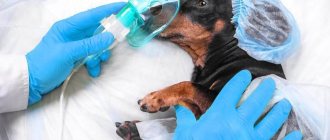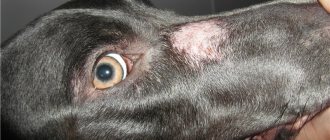Tremors in dogs, or tremors, are rhythmic, involuntary muscle movements. All the muscles of the body can tremble or, for example, only the muscles of the limbs; the head can shake or make constant movements. Trembling often occurs in easily excitable, emotional dogs, in almost all dogs of small and decorative breeds during any experience - fear, joy, any stress. In this case, it goes away on its own after some time, is normal for a dog and does not require a visit to the doctor. Most often in such cases, the dog trembles all over the body or only the limbs, most often the hind legs shake. Animals with easily excitable nervous systems may tremble under stress; in this case, a visit to a veterinarian is not necessary.
Shivering is also a natural way of adapting to short-term hypothermia - rapid, frequent muscle contractions increase the release of heat. Dogs are better adapted to low temperatures than humans, however, if the dog begins to shiver during winter walks, you should not drag them out, they should be shorter, or you can try to provide your pet with clothes. Prolonged hypothermia can already lead to the development of diseases.
Trembling can also be a symptom of some pathology. Let's look at several situations in which it is necessary to consult a doctor and find out the cause of tremor in a dog.
In what cases is it necessary to see a veterinarian:
- Trembling is accompanied by depression and apathy, lethargy, weakness,
- The dog has no appetite
- Vomiting, diarrhea,
- The dog's refusal to walk and move,
- In addition to trembling, the appearance of incomprehensible movements of the head, body parts, and convulsions.
- The appearance of dark or red urine, discharge from the loop or urethra.
If this condition occurs suddenly, for no apparent reason (for example, physical exertion), the dog is trembling and breathing rapidly, breathing is difficult - it is necessary to urgently contact a veterinary clinic.
Diagnostics
Only a veterinarian can make a diagnosis based on the information collected and laboratory tests. The owner should be alert to symptoms that bother the pet:
- whines in pain, rubs his ear with his paws;
- when shaking your head, squelching sounds are heard;
- swelling, redness of the skin;
- unpleasant odor from the ears;
- enlargement of the submandibular lymph nodes;
- lethargy, apathy, depression.
To understand what to do when a dog shakes its ears, you need to find out the reasons that caused this behavior.
Obsessive states
Some deviations in a dog’s behavior, which we often consider oddities, are actually obsessive-compulsive disorders, or obsessive-compulsive neuroses. Many of them are familiar to pet owners:
- Circling behind your own tail.
- Excessive, pathological neatness, when the dog literally spends hours licking itself.
- Trying to chew out fleas that he doesn't actually have.
- Sucking paws or tufts of hair on your body.
- Eating objects that are not edible, including one’s own or someone else’s droppings.
- Unmotivated aggression.
The mechanism is triggered by factors that are strong irritants for the sensitive nervous system. Obsessive states can only be treated comprehensively, using medications, replacement training and rewards for correctly following commands and calm behavior.
How to distinguish a tremor from intentional shaking of the head?
When an English bulldog's head shakes uncontrollably, without loss of orientation in space, he does not shake his ears or scratch them at other times - we are not talking about otitis media or a tick. This symptom can be observed both at certain periods - immediately before or after sleep, and chaotically during the day.
If, even with a frighteningly uncontrolled tremor, the dog still tries to scratch its ears and rubs them the rest of the time, it needs to be examined for otitis media. Unfortunately, this disease in an advanced stage (and not always due to the fault of the owner) gives dangerous complications and affects hearing, reactions, and coordination of movements.
Causes and types of intoxication
Dogs are completely picky eaters; they can swallow absolutely anything that piques their interest. This behavior requires serious attention from the owner to the pet. The entry of spoiled or low-quality products, poisons, or toxins into the gastrointestinal tract causes severe intoxication of the body.
Up to 90% of cases of poisoning can be avoided if you are more careful and follow a number of recommendations:
- Organizing a proper diet. The dog's diet should be balanced and not limited to meat alone, otherwise it may cause protein intoxication. You should not feed your pet spoiled foods, cheap food containing non-food dyes or toxic components. Feeding cat food leads to an overdose of taurine and protein. Unwashed fruits and vegetables are dangerous pesticides. It is also important to properly organize feed storage.
- Controlling your pet during walks. Dogs often tend to pick up anything on the street that seems edible to them. This may be justified by an unbalanced diet or vitamin deficiency. In such cases, adjusting the diet and prescribing a course of vitamins helps.
- All chemicals and medications should be kept out of reach; the dog may swallow them simply because of the attractive smell. Regular chocolate and raisins can serve as poison. Such products are dangerous for your pet's body.
- Be sure to check the expiration date of medications used to treat your dog: medications for the prevention of blood-sucking parasites, medications for worms.
All types of poisoning are divided into two main categories:
1. Food intoxication. Caused when a toxic substance enters a dog's esophagus. Ingestion of poison, medicinal or chemical substances, licking toxic substances from the fur.
2. Non-food intoxication. Entry of toxins into the body by any route other than the digestive tract: snake and insect bites, inhalation of toxic fumes, poison entering through skin pores, poisoning with substances used to treat parasites, shampoos, etc.
The effectiveness of treatment directly depends on the accuracy of determining the cause and method of intoxication of the body. It is worth considering that the first visible signs of poisoning appear seven hours after the poison enters the body. In cases with toxic substances or rat poison, symptoms of etching appear much earlier, about three hours is enough.
Prevention
Following simple rules will help protect your pet from ear diseases:
- Carry out a daily inspection of the ears, pay attention to any changes in skin color, the presence of wax, odor, discharge;
- do not allow water to get inside the ear canal while swimming, and if this happens, be sure to get it wet;
- clean regularly;
- do not allow hypothermia (especially for small breeds);
- Avoid contact of your pet with stray dogs and cats (they are carriers of pathogens of dangerous diseases);
- Carry out antiparasitic treatment regularly.
Treatment
Depending on the diagnosis, the animal is given specific therapy, this may include treatment of renal failure, leptospirosis, removal of tumors or foreign bodies, surgical treatment of the spine, antibiotic therapy for inflammatory diseases, etc. For a sick animal with tremors, physical activity is not recommended and a complete, balanced diet is indicated.
Trembling in dogs - video interview with a veterinarian:
You should not delay your visit to the doctor; in this case, there is a risk of developing pathologies that are dangerous to health and life.
Click on the phone number and call our veterinary center right now 8 or you can request a call back. (c) Veterinary center for the treatment and rehabilitation of animals “Zoostatus”. Varshavskoe highway, 125 building 1. tel.
What to do at home
Many owners have a question: “How to help a dog at home?” The answer is clear: strictly follow the doctor’s instructions and do not self-medicate, as it can lead to irreversible consequences. The maximum that can be done is to create a comfortable environment for the dog, provide it with good care and quality feeding.
As the disease progresses and the dog becomes completely helpless, the owner must be prepared for the fact that he will have to care for the pet, remove feces in a timely manner, and perform anti-bedsore massage.











